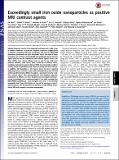| dc.contributor.author | Kaul, Michael G. | |
| dc.contributor.author | Chen, Ou | |
| dc.contributor.author | Li, Nan | |
| dc.contributor.author | Okada, Satoshi | |
| dc.contributor.author | Cordero, Jose M. | |
| dc.contributor.author | Heine, Markus | |
| dc.contributor.author | Farrar, Christian T. | |
| dc.contributor.author | Adam, Gerhard | |
| dc.contributor.author | Ittrich, Harald | |
| dc.contributor.author | Nielsen, Peter | |
| dc.contributor.author | Bawendi, Moungi G. | |
| dc.contributor.author | Wei, He | |
| dc.contributor.author | Bruns, Oliver Thomas | |
| dc.contributor.author | Hansen, Eric Calvin | |
| dc.contributor.author | Barch, Mariya | |
| dc.contributor.author | Wisniowska, Agata Elzbieta | |
| dc.contributor.author | Jasanoff, Alan Pradip | |
| dc.contributor.author | Montana Fernandez, Daniel M | |
| dc.contributor.author | Chen, Yue, M. Eng. Massachusetts Institute of Technology | |
| dc.date.accessioned | 2017-09-15T19:15:26Z | |
| dc.date.available | 2017-09-15T19:15:26Z | |
| dc.date.issued | 2017-02 | |
| dc.date.submitted | 2016-11 | |
| dc.identifier.issn | 0027-8424 | |
| dc.identifier.issn | 1091-6490 | |
| dc.identifier.uri | http://hdl.handle.net/1721.1/111571 | |
| dc.description.abstract | Medical imaging is routine in the diagnosis and staging of a wide range of medical conditions. In particular, magnetic resonance imaging (MRI) is critical for visualizing soft tissue and organs, with over 60 million MRI procedures performed each year worldwide. About one-third of these procedures are contrast-enhanced MRI, and gadolinium-based contrast agents (GBCAs) are the mainstream MRI contrast agents used in the clinic. GBCAs have shown efficacy and are safe to use with most patients; however, some GBCAs have a small risk of adverse effects, including nephrogenic systemic fibrosis (NSF), the untreatable condition recently linked to gadolinium (Gd) exposure during MRI with contrast. In addition, Gd deposition in the human brain has been reported following contrast, and this is now under investigation by the US Food and Drug Administration (FDA). To address a perceived need for a Gd-free contrast agent with pharmacokinetic and imaging properties comparable to GBCAs, we have designed and developed zwitterion-coated exceedingly small superparamagnetic iron oxide nanoparticles (ZES-SPIONs) consisting of ∼3-nm inorganic cores and ∼1-nm ultrathin hydrophilic shell. These ZES-SPIONs are free of Gd and show a high T1 contrast power. We demonstrate the potential of ZES-SPIONs in preclinical MRI and magnetic resonance angiography. | en_US |
| dc.description.sponsorship | National Institutes of Health (U.S.) (Grant 1U54-CA119349) | en_US |
| dc.description.sponsorship | National Institutes of Health (U.S.) (Grant 9-P41-EB015871-26A1) | en_US |
| dc.description.sponsorship | United States. Army Research Office (Grant W911NF-07-D-0004) | en_US |
| dc.description.sponsorship | National Institutes of Health (U.S.) (R01-MH103160) | en_US |
| dc.description.sponsorship | National Institutes of Health (U.S.) (R01-DA028299) | en_US |
| dc.language.iso | en_US | |
| dc.publisher | National Academy of Sciences (U.S.) | en_US |
| dc.relation.isversionof | http://dx.doi.org/10.1073/pnas.1620145114 | en_US |
| dc.rights | Article is made available in accordance with the publisher's policy and may be subject to US copyright law. Please refer to the publisher's site for terms of use. | en_US |
| dc.source | PNAS | en_US |
| dc.title | Exceedingly small iron oxide nanoparticles as positive MRI contrast agents | en_US |
| dc.type | Article | en_US |
| dc.identifier.citation | Wei, He et al. “Exceedingly Small Iron Oxide Nanoparticles as Positive MRI Contrast Agents.” Proceedings of the National Academy of Sciences 114, 9 (February 2017): 2325–2330 © 2017 National Academy of Sciences | en_US |
| dc.contributor.department | Harvard University--MIT Division of Health Sciences and Technology | en_US |
| dc.contributor.department | Massachusetts Institute of Technology. Department of Biological Engineering | en_US |
| dc.contributor.department | Massachusetts Institute of Technology. Department of Brain and Cognitive Sciences | en_US |
| dc.contributor.department | Massachusetts Institute of Technology. Department of Chemistry | en_US |
| dc.contributor.department | Massachusetts Institute of Technology. Department of Materials Science and Engineering | en_US |
| dc.contributor.department | Massachusetts Institute of Technology. Department of Nuclear Science and Engineering | en_US |
| dc.contributor.mitauthor | Wei, He | |
| dc.contributor.mitauthor | Bruns, Oliver Thomas | |
| dc.contributor.mitauthor | Hansen, Eric Calvin | |
| dc.contributor.mitauthor | Barch, Mariya | |
| dc.contributor.mitauthor | Wisniowska, Agata Elzbieta | |
| dc.contributor.mitauthor | Jasanoff, Alan Pradip | |
| dc.contributor.mitauthor | Montana Fernandez, Daniel M | |
| dc.relation.journal | Proceedings of the National Academy of Sciences | en_US |
| dc.eprint.version | Final published version | en_US |
| dc.type.uri | http://purl.org/eprint/type/JournalArticle | en_US |
| eprint.status | http://purl.org/eprint/status/PeerReviewed | en_US |
| dspace.orderedauthors | Wei, He; Bruns, Oliver T.; Kaul, Michael G.; Hansen, Eric C.; Barch, Mariya; Wiśniowska, Agata; Chen, Ou; Chen, Yue; Li, Nan; Okada, Satoshi; Cordero, Jose M.; Heine, Markus; Farrar, Christian T.; Montana, Daniel M.; Adam, Gerhard; Ittrich, Harald; Jasanoff, Alan; Nielsen, Peter; Bawendi, Moungi G. | en_US |
| dspace.embargo.terms | N | en_US |
| dc.identifier.orcid | https://orcid.org/0000-0001-7188-8105 | |
| dc.identifier.orcid | https://orcid.org/0000-0002-3672-660X | |
| dc.identifier.orcid | https://orcid.org/0000-0002-5172-9171 | |
| dc.identifier.orcid | https://orcid.org/0000-0002-2834-6359 | |
| dc.identifier.orcid | https://orcid.org/0000-0001-7152-2816 | |
| mit.license | PUBLISHER_POLICY | en_US |
